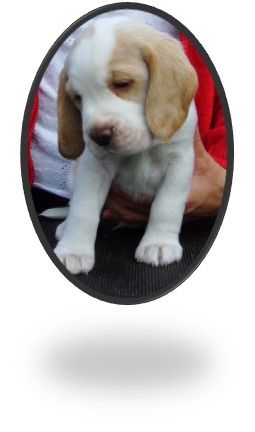NCCD
LET’S TALK ABOUT HEALTH ISSUES IN BEAGLES!
This week’s health is Neonatal Cerebellar Cortical Degeneration (NCCD).
Please be aware that the following information is designed to be informative only. It not a medical or clinical paper, the sole purpose to allow you as a beagle owner or a prospective beagle owner the opportunity to be aware of health issues that could occur. As always, it is recommended that you contact your vet and discuss any concerns that you have. If you are looking to purchase a puppy, ask questions like: What genetic testing do you do? Remember a genetic test is different from health testing puppies.
What is it?
NCCD is a degenerative condition of the cerebellum, this is the part of the brain that controls co-ordination and motor control. A young puppy will start to show signs as they begin to walk (around 3 weeks). They will often fall over, be unco-ordinated and have very poor balance. Other symptoms are jerky movements of the head and feet, look like they are staggering, legs can cross as the try to walk and they will utilise a wide stance to help them balance. There is no treatment for affected puppies, the outcome for most of these puppies is euthanasia.
No affected beagle should be used in a breeding program. If a beagle is a carrier of the gene, it should only be bred to a beagle that is clear of the gene.
At this point I would like to introduce a very brave lady, Jaqui Walton of Vigor Beagles in the UK. It is through her dedication and personal heartache that we can test for NCCD.
In the following article Jaqui tells of her journey.
 NCCD – My Journey
NCCD – My Journey
There has been some confusion and anger amongst the breed surrounding the announcement the AHT released earlier this year in regards to the condition now known as NCCD.
As I am the breeder that provided the AHT with the affected pup, I would like to try and explain the journey I took to get to the point we are today. Some of you may know this condition as CHP, wibbly wobbly puppies or tumbling puppy syndrome.
This test was not born overnight. My first 2 affected puppies were born in 2009 from a litter of 7. At the time they were initially misdiagnosed as swimmers and I spent a terrific amount of money being taught how to affectively give these pups hydrotherapy and physiotherapy. I duly spent 15 minutes per puppy every hour for 8 hours a day administering the treatment they required. At the age of 8 weeks Rocky and Ruby were taken to my vet, along with the rest of the litter for their 8 week jabs. At this point my vet decided that they were not making the progress they should have and advised me that she thought it could be CHP. I was advised that there was no cure for this condition and I took the pups home to do yet more research. After several phone calls to neurologists, vets and breeders I took the decision to have the pups put to sleep. The brain of the worst affected pup was sent away for analysis and the IDEXX report came back as inconclusive. I was left still not knowing 100% whether this condition was hereditary or caused by a viral, bacterial or fungal infection. It had been a very traumatic and emotionally draining time for me and I was still left with no answers.
In 2011 I had a litter which contained the affected puppy that I donated to the AHT. He was again from a litter of 7. When Tom was three weeks old it became apparent to me that he was suffering from the same condition as the other two puppies. I took advice on what to do through the normal channels and following the advice, contacted several institutions in the USA. Unfortunately they were only able to store DNA and although aware of the condition were not actively trying to work on a test. I then contacted Holga Volk, head of neurology at the Royal Veterinary College who had helped me previously and I contacted Elsa Beltran head of neurology at the AHT as I had attended the Beagle Health Seminar held there and was aware of her work.
 Both institutions responded to my request for help but it was the AHT that responded first and so they are the ones that I have worked with. They have been and continue to be exceptionally supportive throughout the whole thing.
Both institutions responded to my request for help but it was the AHT that responded first and so they are the ones that I have worked with. They have been and continue to be exceptionally supportive throughout the whole thing.
I took the second litter of pups along with the dam and sire down to the AHT for a consultation with Elsa. The dogs were all thoroughly examined and tested and DNA was taken from them all. At the end of the consultation I was told that Tom had a neurological condition that he was no going to recover from. In order to find out what his condition was and to try and establish the cause I agreed to leave Tom with the AHT for them to do their investigations. It was the most heart breaking decision I have ever had to make.
Tom was euthanized the next day and every conceivable test was performed on him including MRI scans, bloods etc etc. All the tests for infection, viral, fungal, bacterial etc were negative and so his brain was then examined and that was when I was told that the condition was undoubtedly genetic. Another massive smack in the face.
Tom’s results and DNA were then passed over to Cathryn Mellersh and her team in Genetics. This is where, through new ways of using technology the genetic mutation was found. NCCD was found because it is very unusual and it was made possible by the fact that it is caused by a highly obvious mutation that has a ‘catastrophic’ effect on the protein it codes for and because they were provided with the genetic material from the affected tissue. Not all research projects, sadly, will go as smoothly as this one did.
I then set about contacting every owner of every dog that had been sired by or born to the carrier dogs, whether by me or by other people. I explained my case and asked if they would be prepared to provide DNA for me to send to the AHT to enable the research for the test to continue. I was overwhelmed by the support of my puppy owners and had a 100% take-up and to them, I am eternally grateful for their help and continued support.
 Once all the DNA I had collected had been tested a control group of dogs where used to verify the test. Of the 134 control swabs tested 8 were carriers and this together with my DNA results is where the average of 5 in 100 dogs was derived.
Once all the DNA I had collected had been tested a control group of dogs where used to verify the test. Of the 134 control swabs tested 8 were carriers and this together with my DNA results is where the average of 5 in 100 dogs was derived.
There are many other things that happened along the way, but if I documented everything I would have to write a book.
I hope this has clarified things and should anyone wish to discuss the condition with me I am more than willing to share my experience. I am not a vet and will openly admit this has been a long and painful journey, but unless we all start to be open and honest about the conditions in our breed we will NEVER be able to secure it’s health and it’s future.
Written in the hope that you will never have to suffer the anguish that I did and so the memory of Rocky, Ruby and Tom will live on and their short time on this earth was not in vain.
Jaqui Walton
Vigor Beagles
Jaqui has also produced a video that shows the affected puppies, it is heartbreaking to watch these beautiful puppies struggle to walk and play.
(Jaqui if possible could you add the link for the video?)
The difference between NCCD and other health issues that have been discussed is the outcome for an affected beagle. Treatment is available for other genetic diseases, at the present time there is no treatment for a puppy with NCCD. This is why it is so important that health testing has been carried out.
More information can be found in the following places:
*Beagle Health & Genetics Facebook Group
*NCCD (this group was started by Jaqui.)
